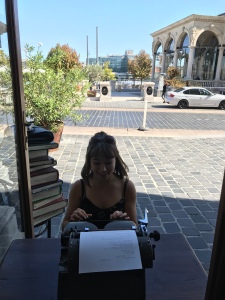High waving heather, ‘neath stormy blasts bending
Midnight and moonlight and bright shining stars
Darkness and glory rejoicingly blending
Earth rising to heaven and heaven descending
Man’s spirit away from its drear dungeon sending
Bursting the fetters and breaking the bars
All down the mountain sides, wild forest lending
One mighty voice to the life-giving wind
Rivers their banks in the jubilee rending
Fast through the valleys a reckless course wending
Wider and deeper their waters extending
Leaving a desolate desert behind
Shining and lowering and swelling and dying
Changing for ever from midnight to noon
Roaring like thunder, like soft music sighing
Shadows on shadows advancing and flying
Lightning-bright flashes the deep gloom defying
Coming as swiftly and fading as soon
An almost defining, certainly recurring feature of Emily Brontë’s poetry appears to be that the first line of the piece often doubles as its title; it certainly allows for easy identification, but I think in the case of ‘High Waving Heather’ it adds a simplicity and natural ease to Brontë’s enthralling description. From the outset she establishes that there will be no affectation or pretence – simply an honest and profoundly painted picture of this scene of nature, tumult and transience.
By using newly invented words (’rejoicingly’) which express meaning far more effectively than any which Microsoft Word would recognise, and playing with the traditional regulations of word order to achieve a pleasing rhyme, Brontë creates a sense of playful wildness which mirrors the tempestuous scene of ‘wild forests’ and ‘stormy blasts’ and suggests that the concept of breaking the rules in the name of beauty, which Nature herself often practises, should be embraced.
Indeed, she emphasises the idea of escape from convention when she speaks of ‘man’s spirit…bursting the fetters and breaking the bars’ – a powerful metaphor of railing against any form of imprisonment, encouraging us once again to disobey rules which are spiritually or creatively suppressive.
A sense of inevitability and eternality is also given by the satisfying and regular rhyme scheme. However, though the ABAAAB pattern is consistent throughout the three verses, it is original and captivating – maintaining the pleasing lull of the typical ABAB or AABB but with a little more character. It also serves to attract us to what are perhaps Brontë’s favourite aspects of the scene, or at least her prettiest imagery; ‘bright shining stars’ and ‘life giving wind’ are both end focussed on the first B line of their verses, making them stand out as the most prominent features worthy of our appreciation.
The almost tautological (tautology: using two words in succession which have the same meaning) ‘desolate desert’ is drawn to our attention by its alliteration, and amplifies the image of barrenness which ever-changing nature leaves behind, augmenting our perception of her strength, power and majesty.
The transience which this suggests is reinforced by the present participle ‘dying’, which seems out of place in such a celebratory poem describing action and vitality. In fact, its inclusion strengthens this point: the death of one thing is the birth of another, and the ‘dying’ Brontë speaks of gives a rather more dynamic, ever-shifting image than a tragic one.
Brontë’s double simile comparing the river and its roar (or arguably the wind, the entire scene, or any aspect of it which the reader chooses to favour) to ‘thunder’ and ‘soft music sighing’ seems contradictory but in fact creates an image of outburst and repentance, or maybe eternal change. Though the two have connotations of anger and melancholy respectively it is difficult for the reader to be saddened or feel negatively about the magnificent scene, with its lightening which ‘def[ies]’ the ‘deep gloom’ (perhaps in both a figurative and literal sense). Instead our only negative response is channelled, upon Brontë’s parting sentiment, into regret that the glorious picture of nature which she has painted for us ‘com[es] swiftly’ and ‘fad[es] as soon’.
Feel free to comment below, and share what you think of Brontë’s technique, the poem itself or the themes it deals with.

Very nicely done.
LikeLiked by 1 person
Thank you! 🙂
LikeLike
https://www.poetryfoundation.org/resources/learning/core-poems/detail/44402
This reminds me of Hopkins’ famous poem
LikeLike
Very interesting analysis! I too find this beautiful poem contradictory and full of opposite images. I think of it as a description of the british heather landscapes’ (although I’ve never been there) ever changing weather and colours, along with the power of nature. I just recently wrote a musical piece on this poem which will be performed in the end of may here in Sweden. I love Emily’s poems and they just are so rewarding to set music to. Cheers!
LikeLiked by 1 person
It really is a powerful picture which she paints. That sounds wonderful – I’d love to hear your piece! Thanks for reading 🙂
LikeLike
Very good analysis and above all I love seeing how others — not only me — are so appreciative of this wondrous work of poetic artistry … visions of it frequently resurface in my thoughts like memories of people I have been singularly amazed with … so indebted to Emily Bronte for this brilliant gift.
LikeLiked by 1 person